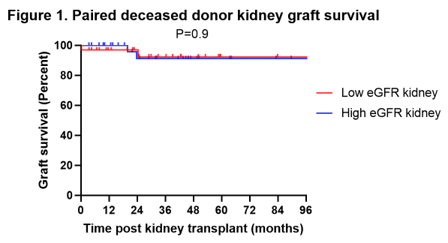Effect of Discordant Kidney Function at Transplant: A Single Center Analysis of Deceased Donor Paired Kidneys
1Nephrology, Hamad Medical Corporation, Doha, Qatar, 2Internal Medicine, Hamad Medical Corporation, Doha, Qatar, 3Transplant Surgery, Hamad Medical Corporation, Doha, Qata
Meeting: 2020 American Transplant Congress
Abstract number: C-071
Keywords: Cadaveric organs, Graft failure, Graft function, Kidney transplantation
Session Information
Session Name: Poster Session C: Kidney Complications: Non-Immune Mediated Late Graft Failure
Session Type: Poster Session
Date: Saturday, May 30, 2020
Session Time: 3:15pm-4:00pm
 Presentation Time: 3:30pm-4:00pm
Presentation Time: 3:30pm-4:00pm
Location: Virtual
*Purpose: Analysis of paired kidneys from deceased donors has the advantage of eliminating donor and center related biases seen in previous studies that evaluated kidney graft function and graft outcomes. Our center has the advantage of having a single organ procurement organization and the only transplant center for the whole country. This study aims to evaluate recipient risk factors that lead to discordant low eGFR of deceased kidney pairs at the early post-transplant period and evaluate long term outcomes of the discordant kidneys.
*Methods: We retrospectively evaluated all deceased donors transplants since 2010. There were 64 kidney pairs from 32 deceased donors (mean age: 41 years, 16% female, and 13% had KDPI >85%). Kidney function was calculated at 2 weeks post transplant using CKD-EPI formula. Discordant pairs with eGFR difference more than 5 mL/min were divided into low eGFR group and high eGFR groups. Donor and recipient variables were analyzed between the two groups using Wilcoxon and chi square tests for continuous and categorical variables, respectively.
*Results: All pairs had discordance in eGFR more than 5 mL/min and majority (75%) had eGFR discordance more than 10 mL/min post transplant. We did not observe a difference in age, gender or race as shown in table 1. Preformed DSA were present and delayed graft function occurred more frequently in low eGFR but were not significant (21% vs. 18%, P=0.9 and 9% vs. 3%, P=0.3, respectively). Acute rejection was also more frequent in low eGFR (19% vs. 6%, P=0.3). The mean eGFR difference between the two groups decreased after 6 months and graft survival was not different as shown in figure 1.
*Conclusions: Our single center analysis of paired deceased donor transplants demonstrated that a decrease in initial renal function may be associated with immunologic and ischemia reperfusion injury. However, despite a difference in kidney function at the time of transplant and recipient variables, both paired kidney functions normalize and perform well over long term follow up.
To cite this abstract in AMA style:
Abuhelaiqa E, Alkadi M, Mansour S, Mathew L, Makableh F, Nauman A, Fituri O, Asim M, Fadhil R, Al-Malki HA. Effect of Discordant Kidney Function at Transplant: A Single Center Analysis of Deceased Donor Paired Kidneys [abstract]. Am J Transplant. 2020; 20 (suppl 3). https://atcmeetingabstracts.com/abstract/effect-of-discordant-kidney-function-at-transplant-a-single-center-analysis-of-deceased-donor-paired-kidneys/. Accessed December 14, 2025.« Back to 2020 American Transplant Congress


